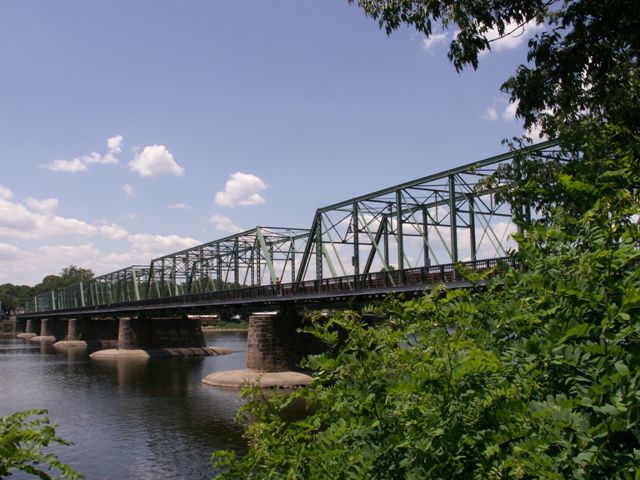We Recommend:
Bach Steel - Experts at historic truss bridge restoration.
BridgeHunter.com Phase 1 is released to the public! - Visit Now
New Hope - Lambertville Bridge

Primary Photographer(s): Nathan Holth and Rick McOmber
Bridge Documented: July 11, 2008
New Hope and Lambertville: Bucks County, Pennsylvania and Hunterdon County, New Jersey: United States
1904 By Builder/Contractor: Shoemaker Bridge Company of Pottstown, Pennsylvania
2004
171.0 Feet (52.1 Meters)
1,053.0 Feet (321 Meters)
20.3 Feet (6.19 Meters)
6 Main Span(s)
9741199910005

View Information About HSR Ratings
Bridge Documentation
Note: At the time this bridge was built, Shoemaker Bridge Company was known as Lewis F. Shoemaker and Company. See this page for more information.
View Archived National Bridge Inventory Report - Has Additional Details and Evaluation
Visit Delaware River Joint Toll Bridge Commission's Page For This Historic Bridge
Finding a long, multi-span pin-connected through truss bridge is becoming quite difficult. Large river crossings tend to be fewer in number, therefore they tend to be busier crossings, and bridges as old as pin-connected truss bridges have mostly been replaced. Indeed, this bridge is fairly busy, but it has been well preserved and continues to function safely and carries non-truck traffic at a four ton weight limit.
The bridge was built by the Lewis F. Shoemaker and Company, Schuylkill Bridge Works, of Pottstown, Pennsylvania. R. G. Devlin was listed as the engineer. Work on building the bridge began on April 25, 1904, and was completed in June 27, and the bridge was opened to traffic on July 23. The overall cost was $62,000. The original wooden deck was installed by Armstrong and Latta of Philadelphia.
This bridge is owned by the Delaware River Joint Toll Bridge Commission (DRJTBC). The DRJTBC has a unique commitment to maintaining the many historic bridges under its ownership, and working with the communities the bridges serve, and sets an example for the rest of the country to follow. The front page of their website often features a photo of a historic bridge, and their slogan is Preserving Our Past, Enhancing Our Future. How many other road/bridge agencies in the United States promote their commitment to historic bridges in this way? Not many.
Not only is the DRJTBC an example of how money might be better spent in regards to non-toll bridges, the DRJTBC bridges are also a great reference when arguing that a historic bridge can be rehabilitated and can also safely continue to function as a vehicular crossing.
The plaque for this bridge is no longer on this bridge and is located in a rather strange place, in the Swan Hotel in Lambertville. The original bridge company's plaque for the 1904 replacement bridge is located there and is used as the firewall for the wooden stove that heats the bar area.
Information and Findings From Pennsylvania's Historic Bridge InventoryDiscussion of Bridge The 1904, six-span, pin connected Pratt thru truss bridge built on the substructure of an earlier wood covered truss bridge is a contributing resource to the New Hope Village Historic District. The bridge is owned by the Delaware River Joint Toll Bridge Commission. It is a free facility. Discussion of Surrounding Area The bridge carries a two lane road connecting New Hope and Lambertville over the Delaware River. Both towns are historic districts, and the bridge is a contributing resource to the New Hope Historic District. Bridge Considered Historic By Survey: Yes |
![]()
Photo Galleries and Videos: New Hope - Lambertville Bridge
Bridge Photo-Documentation
Original / Full Size PhotosA collection of overview and detail photos. This gallery offers photos in the highest available resolution and file size in a touch-friendly popup viewer.
Alternatively, Browse Without Using Viewer
![]()
Bridge Photo-Documentation
Mobile Optimized PhotosA collection of overview and detail photos. This gallery features data-friendly, fast-loading photos in a touch-friendly popup viewer.
Alternatively, Browse Without Using Viewer
![]()
Maps and Links: New Hope - Lambertville Bridge
Coordinates (Latitude, Longitude):
Search For Additional Bridge Listings:
Bridgehunter.com: View listed bridges within 0.5 miles (0.8 kilometers) of this bridge.
Bridgehunter.com: View listed bridges within 10 miles (16 kilometers) of this bridge.
Additional Maps:
Google Streetview (If Available)
GeoHack (Additional Links and Coordinates)
Apple Maps (Via DuckDuckGo Search)
Apple Maps (Apple devices only)
Android: Open Location In Your Map or GPS App
Flickr Gallery (Find Nearby Photos)
Wikimedia Commons (Find Nearby Photos)
Directions Via Sygic For Android
Directions Via Sygic For iOS and Android Dolphin Browser
USGS National Map (United States Only)
Historical USGS Topo Maps (United States Only)
Historic Aerials (United States Only)
CalTopo Maps (United States Only)

